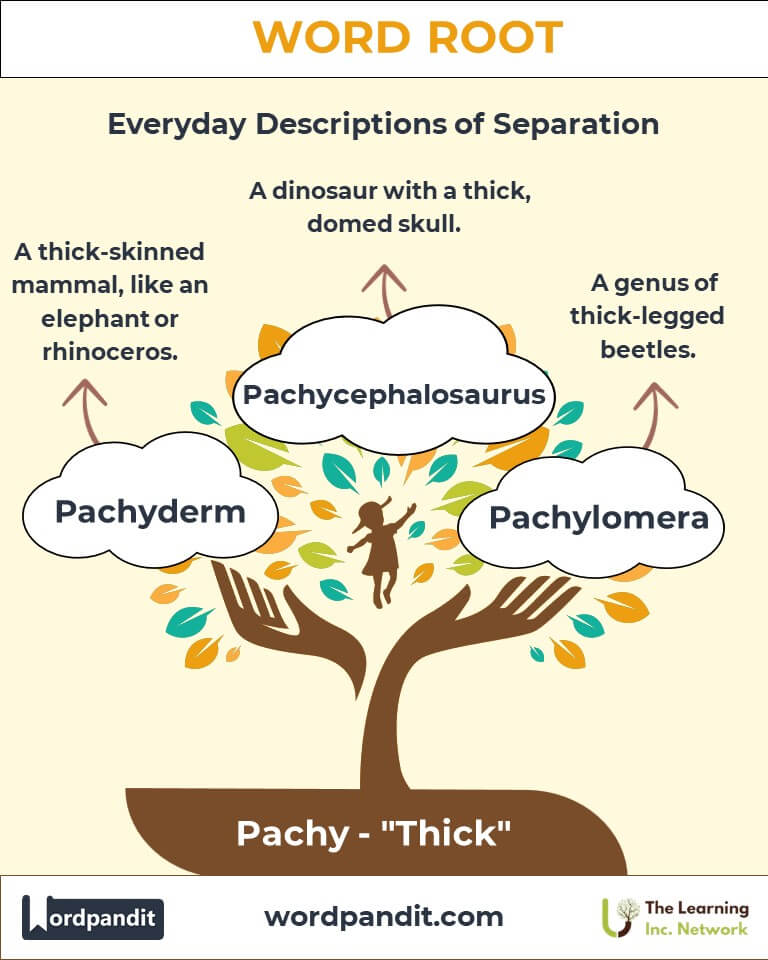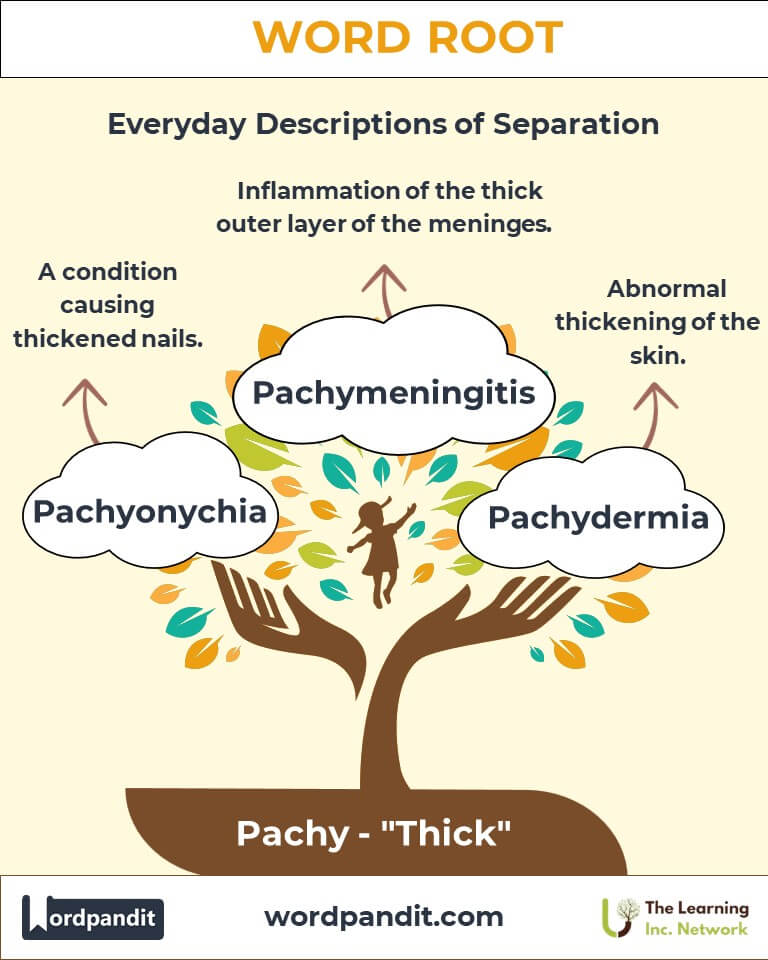Pachy: The Foundation of Thickness in Language and Science
Byline:
Explore the linguistic and scientific impact of the word root "Pachy," derived from Greek, meaning "thick." From zoological terms like "pachyderm" to specialized medical terms such as "pachycephalic," this root embodies the essence of thickness and robustness across various fields of study.

Table of Contents
- Introduction: The Thick Layers of "Pachy"
- Etymology and Historical Journey
- Mnemonic: Unlocking the Power of "Pachy"
- Common Pachy-Related Terms
- Pachy Through Time
- Pachy in Specialized Fields
- Illustrative Story: Pachy in Action
- Cultural Significance of the "Pachy" Root
- The Pachy Family Tree
- FAQs about the Pachy Word Root
- Test Your Knowledge: Pachy Mastery Quiz
- Conclusion: The Robust Legacy of "Pachy"
Introduction: The Thick Layers of "Pachy"
What do elephants and thickened skulls have in common? The root "Pachy," pronounced "pah-kee," ties them together. This Greek-derived word means "thick" and is a cornerstone of terms describing robust, dense, or enlarged characteristics. From pachyderms like rhinoceroses to medical conditions involving thickened tissues, "Pachy" shapes words that emphasize substantial layers or structures.

Etymology and Historical Journey
The root "Pachy" originates from the Greek word pachys, meaning "thick" or "dense." Its application dates back to ancient descriptions of animals with thick skins, such as elephants and hippos, leading to the term pachyderm (thick-skinned). As sciences like medicine and zoology developed, "Pachy" found its way into terminology describing physical conditions and traits, maintaining its association with thickness.
Mnemonic: Unlocking the Power of "Pachy"
To remember "Pachy," imagine an elephant with an impenetrable thick hide standing firmly amidst a storm.
Mnemonic: "Pachy packs a punch with thickness—strong, sturdy, and robust!"
Common Pachy-Related Terms
- Pachyderm: A large, thick-skinned mammal such as an elephant, rhinoceros, or hippopotamus.
Example: "The pachyderm's tough skin protects it from predators and harsh environments." - Pachycephalic: Having an abnormally thick skull.
Example: "Pachycephalic dinosaurs, like Pachycephalosaurus, used their thick skulls in combat." - Pachydermatous: Relating to thickened skin; insensitive or callous.
Example: "Years of manual labor left his hands pachydermatous and rough." - Pachytene: A stage in meiosis where chromosomes thicken and become visible.
Example: "The pachytene phase is critical for genetic recombination during cell division." - Pachymeter: A device used to measure the thickness of the cornea.
Example: "Ophthalmologists use a pachymeter to assess corneal health before surgery."
Pachy Through Time
- Pachyderm (18th Century): Coined during early zoological studies to classify large, thick-skinned mammals.
- Pachycephalosaurus (20th Century): Discovered as a dinosaur species with a dome-shaped, thick skull.
- Pachytene (Modern Biology): Represents "Pachy" in cellular biology, illustrating its expansion into microscopic contexts.
Pachy in Specialized Fields
- Zoology: Pachyderms like elephants, representing thickness and resilience.
- Medicine: Conditions like Pachyonychia and Pachymeningitis emphasize thickened tissues.
- Optometry: Pachymetry measures corneal thickness for surgical assessments.
- Paleontology: Pachycephalosaurus highlights "Pachy" in extinct species.
Illustrative Story: Pachy in Action
In a wildlife sanctuary, Dr. Elena cared for pachyderms rescued from poachers. One day, she discovered an elephant with thickened skin. Using her knowledge of pachydermatous conditions, she developed a salve to heal it. Meanwhile, her colleague studied Pachycephalosaurus fossils, uncovering head-butting behavior. Both efforts celebrated "Pachy" in resilience and science.
Cultural Significance of "Pachy"
The root "Pachy" symbolizes strength and resilience in cultures worldwide. Elephants, classified as pachyderms, represent wisdom and endurance in traditions and art, reflecting the root’s rich symbolic significance.

The Pachy Family Tree
Related Roots and Terms:
- Derm (Greek: skin): Dermatology, Epidermis
- Cephal (Greek: head): Cephalic, Encephalitis
- Thick (Old English): Thickness, Thicket

FAQs About the "Pachy" Word Root
Q: What does "Pachy" mean?
A: "Pachy" means "thick" or "dense" and comes from the Greek word pachys. It is often used to describe physical thickness, such as skin, bones, or even layers in biological or geological contexts.
Q: What animals are classified as pachyderms?
A: Pachyderms are thick-skinned mammals like elephants, rhinoceroses, and hippopotamuses. While the term is outdated in scientific taxonomy, it historically grouped these animals due to their robust, leathery skin, which serves as natural protection.
Q: What does "Pachycephalic" refer to?
A: The term "pachycephalic" describes individuals, animals, or species with abnormally thick skulls. For example, Pachycephalosaurus, a dinosaur, had a thick, dome-shaped skull used for head-butting or display.
Q: Is "Pachy" used in medicine?
A: Yes, "Pachy" is frequently used in medical terminology. Examples include:
- Pachymeter: A device that measures the corneal thickness of the eye.
- Pachymeningitis: Inflammation of the thick dura mater layer surrounding the brain or spinal cord.
Q: What is the significance of "Pachy" in paleontology?
A: In paleontology, "Pachy" appears in names like Pachycephalosaurus, meaning "thick-headed lizard." This dinosaur is known for its domed, thick skull, thought to have been used in combat or mating displays.
Test Your Knowledge: "Pachy" Word Root Quiz
1. What does "Pachy" mean?
2. Which of these describes a pachyderm?
3. What does a pachymeter measure?
4. What does "Pachycephalosaurus" mean?
5. What is "Pachytene" associated with?
Conclusion: The Robust Legacy of "Pachy"
The root "Pachy" encapsulates strength, resilience, and durability, influencing language and science alike. From pachyderms to cellular biology, its versatility continues to inspire advancements and cultural appreciation.












